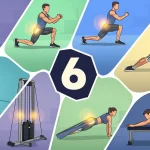Fit People, do you know that yoga is considered a type of exercise? Although it doesn’t involve jumping or running, its benefits are equivalent to other physical exercises.
Yoga has existed since ancient Indian times and remains popular to this day. Many people think yoga is just about sitting cross-legged and meditating, but its movements are very diverse and need to be adjusted according to ability, especially for beginners. So, what is yoga? What is its history? And what benefits can you get? Let’s explore the explanation below!
What is Yoga?
Yoga is an ancient practice that combines physical exercise, breathing, meditation, and life philosophy to achieve balance of body and mind. The word “yoga” comes from Sanskrit, meaning “union” or “unity”. The main goal of yoga is to unite body, mind, and soul, and to achieve inner peace.
Yoga doesn’t require a large field like other sports, as it can be done in a studio or at home. One common form of yoga is Yoga Asanas, where participants sit cross-legged, focusing on breathing and calmness. Through this practice, yoga not only improves physical health but also brings emotional and mental balance, allowing us to face life more calmly and wisely.
History of Yoga
Yoga has a long and rich history, with roots embedded in the spiritual traditions and philosophy of ancient India. The earliest evidence of yoga practice was found on archaeological artifacts from the Indus Valley civilization around 3000 BC. However, the development of yoga as a more systematic spiritual discipline began around 500-200 BC, especially through important texts such as the Bhagavad Gita and the Yoga Sutras written by Patanjali.
In the 19th and 20th centuries, yoga began to be known in the Western world, and its popularity continues to increase, becoming one of the most recognized and practiced forms of physical and mental exercise globally today.
Types of Yoga
Yoga is a practice rich in variety, with each type offering unique benefits that can be tailored to individual needs. Here’s an in-depth explanation of various types of yoga you can try:
1. Aerial Yoga
Aerial Yoga combines traditional yoga with acrobatic arts using a hammock or fabric suspended from the ceiling. This practice helps improve body posture, increase flexibility, and provides a pleasant “flying” sensation. With gravity involved, you can experience deeper stretches without putting excessive pressure on your joints.
2. Floating Yoga
Similar to Aerial Yoga, Floating Yoga is performed on water using a floating board. This adds an extra element of balance, thus strengthening core muscles and improving stability. The calming sensation of water also helps in reducing stress and increasing focus.
3. Gentle Yoga
Gentle Yoga is a soft approach suitable for beginners, the elderly, or those recovering from injuries. The movements are slow and focus on breathing and relaxation, making it ideal for those who want to experience the benefits of yoga without heavy physical pressure.
4. Hatha Yoga
Hatha Yoga is the most basic form of yoga and often becomes the starting point for many people. It includes various basic asanas (poses) combined with breathing techniques, aiming to create balance between body and mind. Hatha Yoga is suitable for all levels, helping to improve body posture, increase flexibility, and teach the basics of meditation.
5. Power Yoga
Power Yoga is a more dynamic version of yoga, combining fast movements that challenge strength and stamina. It’s suitable for those looking for intense physical exercise that also increases muscle strength, balance, and endurance. Power Yoga is often chosen by those who want to get the fitness benefits of yoga while burning calories.
6. Thera Yoga
Thera Yoga or Therapy Yoga is a form of yoga specifically designed for healing and recovery. The focus is on physical and mental rehabilitation, using modified poses to target specific health issues such as back pain, stress, or sleep disorders. This is an ideal choice for those seeking a holistic approach to health.
7. Wheel Yoga
Wheel Yoga uses a yoga wheel tool to assist in performing various asanas. This wheel supports the body in deeper stretches, increasing flexibility, and opening up hard-to-reach areas such as the chest and back. It also helps in developing balance and core strength.
8. Vinyasa Yoga
Vinyasa Yoga is a dynamic and flowing type of yoga, where each movement is connected to the breath. Each pose transitions smoothly to the next, creating a rhythmic and energetic workout. Vinyasa is suitable for those who like to move and want to get cardiovascular benefits while strengthening the body.
9. Ashtanga Yoga
Ashtanga Yoga is a more intense and structured form of yoga, with a series of poses performed in a fixed sequence. This practice demands discipline and dedication, as each session involves a combination of complex movements and breath synchronization. Ashtanga is very suitable for those seeking a deep physical and mental challenge.
10. Bikram Yoga
Bikram Yoga, also known as “Hot Yoga,” is performed in a high-temperature room (about 40°C) with high humidity. It includes a series of 26 poses that are the same in each session. The hot temperature helps increase flexibility and body detoxification through intense sweating. Bikram Yoga is suitable for those who want to increase physical and mental endurance.
11. Yin Yoga
Yin Yoga is a passive and meditative form of yoga, focusing on the body’s connective tissues such as ligaments, bones, and joints. Poses in Yin Yoga are held for longer periods (usually 3-5 minutes), allowing for deeper stretches and total relaxation. This is a great choice for increasing flexibility and achieving peace of mind.
12. Restorative Yoga
Restorative Yoga is a very gentle and calming approach, using props such as pillows and blankets to support the body in comfortable poses. The goal is to relax the nervous system and reduce stress. This is ideal yoga for recovery after injury, heavy stress, or when you need time to truly relax.
13. Iyengar Yoga
Iyengar Yoga emphasizes precision and alignment in each pose, often using props such as blocks, ropes, and chairs to ensure correct posture. This is very beneficial for those who want to deepen their understanding of each asana, as well as for those who need modifications due to physical limitations.
14. Kundalini Yoga
Kundalini Yoga focuses on activating spiritual energy called “kundalini,” which is described as a coiled snake at the base of the spine. This practice combines asanas, pranayama (breathing techniques), mantras, and meditation to awaken this energy and bring higher spiritual awareness. Kundalini is suitable for those interested in spiritual aspects and personal transformation through yoga.
15. Prenatal Yoga
Prenatal Yoga is specifically designed for pregnant women, helping them maintain physical and mental health during pregnancy. The focus is on safe poses for pregnancy, breathing, and relaxation, all of which support preparation for childbirth and postpartum recovery. This is a gentle and effective way to maintain fitness during pregnancy.
Important Benefits of Yoga
Yoga offers a wide range of benefits for physical and mental health. Some important benefits of yoga practice include:
Increasing Flexibility and Strength Through poses targeting various muscle groups, yoga helps increase overall body flexibility and strength.
Reducing Stress Breathing techniques and meditation in yoga help calm the mind and reduce stress levels, making it an effective tool for managing anxiety.
Improving Body Posture By strengthening core muscles and body awareness, yoga can help improve body posture and prevent injuries related to poor posture.
Enhancing Mental Health Yoga is not only good for the body but also for the mind. Meditation and relaxation practices in yoga have been proven to help improve focus, concentration, and overall mental health.
Improving Sleep Quality Yoga can help calm the nervous system and regulate breathing patterns, which can ultimately improve sleep quality.
Supporting Emotional Balance By helping participants become more aware and connected with themselves, yoga can support emotional balance and inner calm development.
Implementing Yoga for Children
Yoga can also be beneficial for children, supporting their mental, emotional, and physical balance. It’s important to ensure an empty stomach, a comfortable practice area, and appropriate clothing when performing yoga asanas for children. This practice is not only beneficial for physical health but also helps children improve concentration and mental calmness.
Conclusion
Yoga is more than just physical exercise; it’s a holistic practice that promotes balance and harmony between body, mind, and soul. With a rich history and various types that can be tailored to individual needs, yoga offers important benefits for physical and mental health.
Are you interested in starting your yoga journey? At FocusFit, we offer various yoga classes that can help you find inner peace while strengthening your body. Let’s start your yoga practice now and feel the benefits!





